Trails West Wildlife
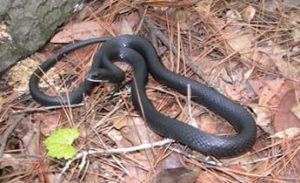 Who said Good Guys don’t wear black? This is an Eastern Black Racer (Coluber constrictor). He’ll grow to between 4 and 5 feet in length. He’s is NOT poisonous and completely harmless to humans. When you approach one, you’ll see why he’s called a “racer”. He preys on lizards, frogs, small snakes and rodents.
Who said Good Guys don’t wear black? This is an Eastern Black Racer (Coluber constrictor). He’ll grow to between 4 and 5 feet in length. He’s is NOT poisonous and completely harmless to humans. When you approach one, you’ll see why he’s called a “racer”. He preys on lizards, frogs, small snakes and rodents.
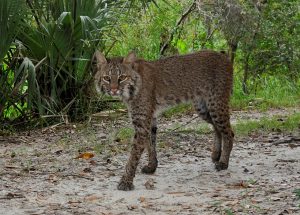 Probably won’t answer to “here kitty”. This is the Florida Bobcat (Lynx rufus). Bobcats are about twice the size of a domestic cat. They are generally tan to yellowish brown with dark brown or black streaks. Their ears are pointed with short, black tufts while the tail is short and gives the appearance of being “bobbed.” Bobcats are stealthy animals and not often seen even though their numbers are abundant. Catching even a fleeting glimpse of this secretive and beautiful creature can make anyone’s outdoor experience more enjoyable. An efficient hunter, the bobcat hunts by sight and usually at night. Seeing a bobcat during the day is not uncommon because they sleep for only 2 to 3 hours at a time.
Probably won’t answer to “here kitty”. This is the Florida Bobcat (Lynx rufus). Bobcats are about twice the size of a domestic cat. They are generally tan to yellowish brown with dark brown or black streaks. Their ears are pointed with short, black tufts while the tail is short and gives the appearance of being “bobbed.” Bobcats are stealthy animals and not often seen even though their numbers are abundant. Catching even a fleeting glimpse of this secretive and beautiful creature can make anyone’s outdoor experience more enjoyable. An efficient hunter, the bobcat hunts by sight and usually at night. Seeing a bobcat during the day is not uncommon because they sleep for only 2 to 3 hours at a time.
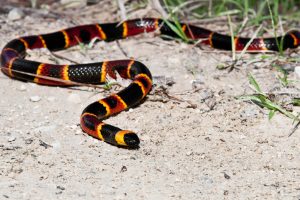 This gorgeous beauty is an Eastern Coral Snake – aka. “Harlequin” Coral Snake (Micrurus fulvius). They grow to approximately 20 to 30 inches in length and are highly poisonous, though bites are rare. They are not aggressive and most bites are from accidental or intentional molestation by people or pets. They are often confused with the Scarlet Kingsnake. The common means of telling the difference is to attempt to remember the color banding sequence, which is confusing at best. The single most reliable way to identify an Eastern Coral Snake is by its blunt black head, which is unmistakable and completely unlike the Scarlet Kingsnake.
This gorgeous beauty is an Eastern Coral Snake – aka. “Harlequin” Coral Snake (Micrurus fulvius). They grow to approximately 20 to 30 inches in length and are highly poisonous, though bites are rare. They are not aggressive and most bites are from accidental or intentional molestation by people or pets. They are often confused with the Scarlet Kingsnake. The common means of telling the difference is to attempt to remember the color banding sequence, which is confusing at best. The single most reliable way to identify an Eastern Coral Snake is by its blunt black head, which is unmistakable and completely unlike the Scarlet Kingsnake.
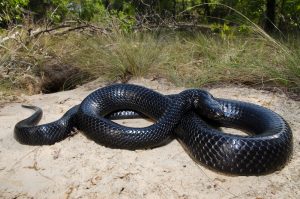 Another Good Guy in black, this is the Eastern Indigo Snake (Drymarchon couperi). Consider yourself very fortunate if you have seen one. This snake is on the State and Federal listings as a Threatened Species. Length is up to 6 feet normally, with a maximum length of 8 feet. Historically found throughout Florida but now rarely encountered. Their diet consists of frogs, lizards, snakes (including venomous species), small turtles and turtle eggs, birds and rats. In the background of the photo is a gopher tortoise burrow. Taking of eastern indigo snakes is prohibited by the Endangered Species Act and defined by the USFWS as an attempt to kill, harm, harass, pursue, hunt, shoot, wound, trap, capture, collect, or engage in any such conduct. Penalties include a maximum fine of $25,000 for civil violations and up to $50,000 and/or imprisonment for criminal offenses, if convicted.
Another Good Guy in black, this is the Eastern Indigo Snake (Drymarchon couperi). Consider yourself very fortunate if you have seen one. This snake is on the State and Federal listings as a Threatened Species. Length is up to 6 feet normally, with a maximum length of 8 feet. Historically found throughout Florida but now rarely encountered. Their diet consists of frogs, lizards, snakes (including venomous species), small turtles and turtle eggs, birds and rats. In the background of the photo is a gopher tortoise burrow. Taking of eastern indigo snakes is prohibited by the Endangered Species Act and defined by the USFWS as an attempt to kill, harm, harass, pursue, hunt, shoot, wound, trap, capture, collect, or engage in any such conduct. Penalties include a maximum fine of $25,000 for civil violations and up to $50,000 and/or imprisonment for criminal offenses, if convicted.
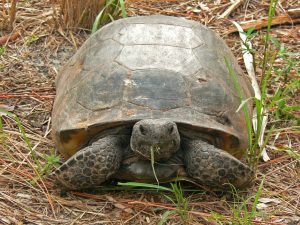 This is the Florida Gopher Tortoise (Gopherus polyphemus). The State of Florida lists them as a Threatened Species and it is against the law to kill, harass or destroy gopher tortoises, their eggs or burrows. A person is subject to arrest and fines for disturbing a gopher tortoise in Florida. Violating the law is a third-degree felony and punishable by up to five years in prison, a $5,000 fine or both.
This is the Florida Gopher Tortoise (Gopherus polyphemus). The State of Florida lists them as a Threatened Species and it is against the law to kill, harass or destroy gopher tortoises, their eggs or burrows. A person is subject to arrest and fines for disturbing a gopher tortoise in Florida. Violating the law is a third-degree felony and punishable by up to five years in prison, a $5,000 fine or both.
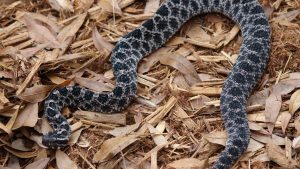 Here we have the Pygmy Rattlesnake (Sistrurus miliarius). Adults are 12 to 24 inches in length. They are poisonous, especially to small children and small pets, but they are not aggressive and most bites are from accidental or intentional molestation by people or pets. They lie concealed in leafy and wooded areas waiting for prey. Many bites are due to people reaching into dense brush or saw palmetto shrubs without checking first.
Here we have the Pygmy Rattlesnake (Sistrurus miliarius). Adults are 12 to 24 inches in length. They are poisonous, especially to small children and small pets, but they are not aggressive and most bites are from accidental or intentional molestation by people or pets. They lie concealed in leafy and wooded areas waiting for prey. Many bites are due to people reaching into dense brush or saw palmetto shrubs without checking first.
